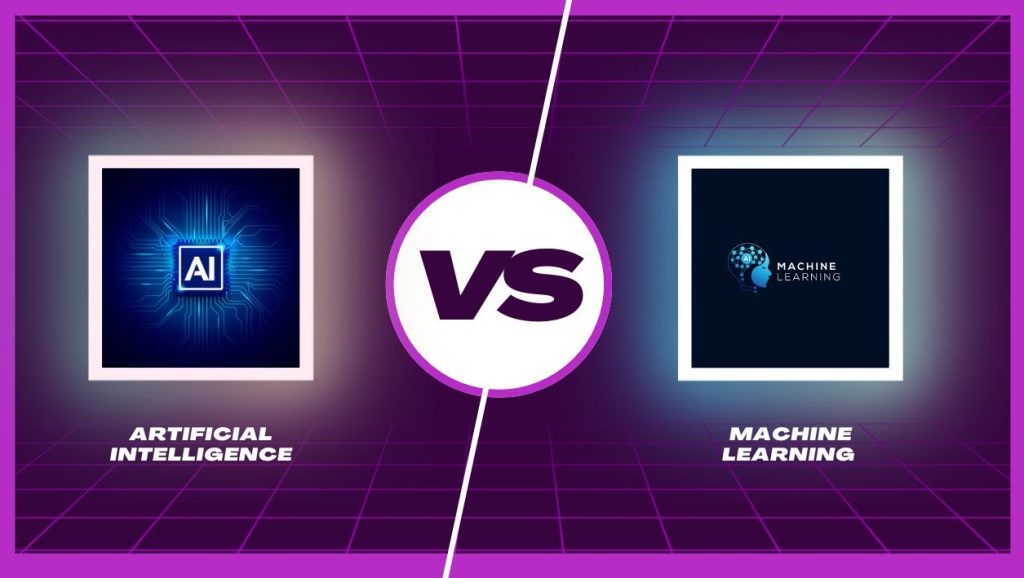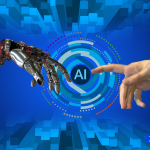AI vs. ML: What’s the Difference and Why Does It Matter?
In today’s technologically advanced world, people frequently use the terms Artificial Intelligence (AI) and Machine Learning (ML) interchangeably, but there exists a significant difference between the two. If you’re curious about what sets them apart and why it matters, you’re in the right place. Let’s dive in.
Understanding AI and ML
A. Artificial intelligence (AI) is the broader concept. Think of AI as the overall goal – creating machines or software that can mimic human intelligence. This includes everything from learning and problem-solving to recognizing speech and understanding natural language. AI is the umbrella term that encompasses various technologies and approaches aimed at making computers think and act like humans.
AI can be further divided into several categories:
- Narrow AI: You have reached a limit, please wait for some time. Narrow AI is currently the most common form of AI.
- General AI: Also known as Strong AI, this type of AI has the potential to understand, learn, and apply intelligence in a broad range of tasks much like a human being. This form of AI is still largely theoretical and is a long-term goal for researchers.
- Artificial Superintelligence (ASI): This is a level of AI where machines surpass human intelligence and capability in all respects. ASI is purely speculative and is a topic of significant debate and concern regarding its potential implications for humanity.
B. Machine Learning (ML), on the other hand, is a subset of AI. ML focuses on algorithms and statistical models that enable computers to enhance their performance on a task through experience. ML systems learn from data and make decisions based on that data, instead of someone explicitly programming them to perform a task. This ability to learn and adapt from experience makes ML particularly powerful.

We can categorize ML into several types:
- Supervised Learning: Supervised Learning: We train the algorithm on labeled data. For example, an ML model can learn to classify emails as spam or non-spam by training on a dataset of labeled emails. It uses known input-output pairs to learn a general rule that maps inputs to outputs.
- Unsupervised Learning: The algorithm uses unlabeled data and must find patterns and relationships in the data on its own. Clustering and association are commonly used techniques here. For instance, an unsupervised learning algorithm can segment customers into different groups based on purchasing behavior.
- Reinforcement Learning: The algorithm learns by interacting with its environment and receiving rewards for performing actions that bring it closer to its goal. People often use this in robotics and game-playing. For example, a reinforcement learning algorithm can learn to play chess by making moves and receiving feedback on whether those moves increase the chance of winning.
Breaking It Down
Here’s a simpler way to think about it:
- AI is the science of making machines smart.
- ML is a method to achieve AI by giving machines access to data and letting them learn for themselves.
Practical Examples
To make it even clearer, let’s look at some practical examples:
- AI Example: Virtual assistants like Siri or Alexa. They can understand your voice commands, search the internet, set reminders, and even tell jokes. AI enables these assistants to interpret and respond to various inputs just like a human would.
- ML Example: Your email’s spam filter. It learns from millions of emails to recognize which ones are spam and which ones aren’t. Over time, it gets better at distinguishing between the two based on patterns and past data.
Why It Matters
Understanding the difference between AI and ML is more than just tech jargon. It has practical implications for businesses and innovation:
Targeted Solutions: Knowing when to apply AI vs. ML helps in designing better solutions. For example, if you need a system that can adapt and improve over time without manual intervention, ML is your go-to. Conversely, a broader AI approach might be more suitable if you need a system that can perform a wide range of tasks but doesn’t necessarily need to learn from new data continuously.
Resource Allocation: Developing AI systems can be resource-intensive. Understanding the specific requirements of your project can help you allocate resources more effectively and avoid unnecessary complexity. For example, deploying an ML model requires significant data collection, storage, and processing power, while implementing a rule-based AI system might be simpler and less costly.
Innovation Potential: By appropriately leveraging AI and ML, companies can drive innovation. AI can provide overarching intelligence, while ML can fine-tune and improve specific functionalities.
The Future is Bright
The interplay between Artificial Intelligence and ML is driving some of the most exciting advancements in technology today. From healthcare and finance to entertainment and beyond, these technologies are transforming industries and creating new possibilities.
Healthcare: Artificial Intelligence and ML are revolutionizing healthcare by enabling personalized medicine, improving diagnostic accuracy, and streamlining administrative tasks. For instance, ML algorithms can analyze medical images faster and more accurately than human radiologists, leading to the early detection of diseases.
Entertainment: AI powers recommendation engines on platforms like Netflix and Spotify, enhancing user experience by suggesting content tailored to individual preferences. ML models analyze viewing and listening habits to predict what users might enjoy next.
Automotive: Self-driving cars are perhaps the most visible example of AI and ML in action. These vehicles use ML algorithms to process data from sensors and cameras, making real-time decisions that allow them to navigate safely.
So, next time someone throws around the terms artificial intelligence and ML, you’ll know exactly what they mean and why they’re crucial in the tech landscape. Artificial intelligence is the dream, and ML is the means to get there. Together, they’re shaping the future in ways we can only begin to imagine.
At Kraftors, we offer development services related to Artificial Intelligence and Machine Learning technologies. We specialize in related technologies and frameworks like NLP, NLU, RAG, Fine Tuning, Python, etc.
Contact Us with your project requirements
We hope you liked the post feel free to post your questions and comments on this burning topic and our experts will provide you with the answers to them.
If you’re interested in learning how to build your first AI model, check out our latest blog post:
Step-by-Step Guide to Building Your First AI Model: From Data Collection to Deployment

